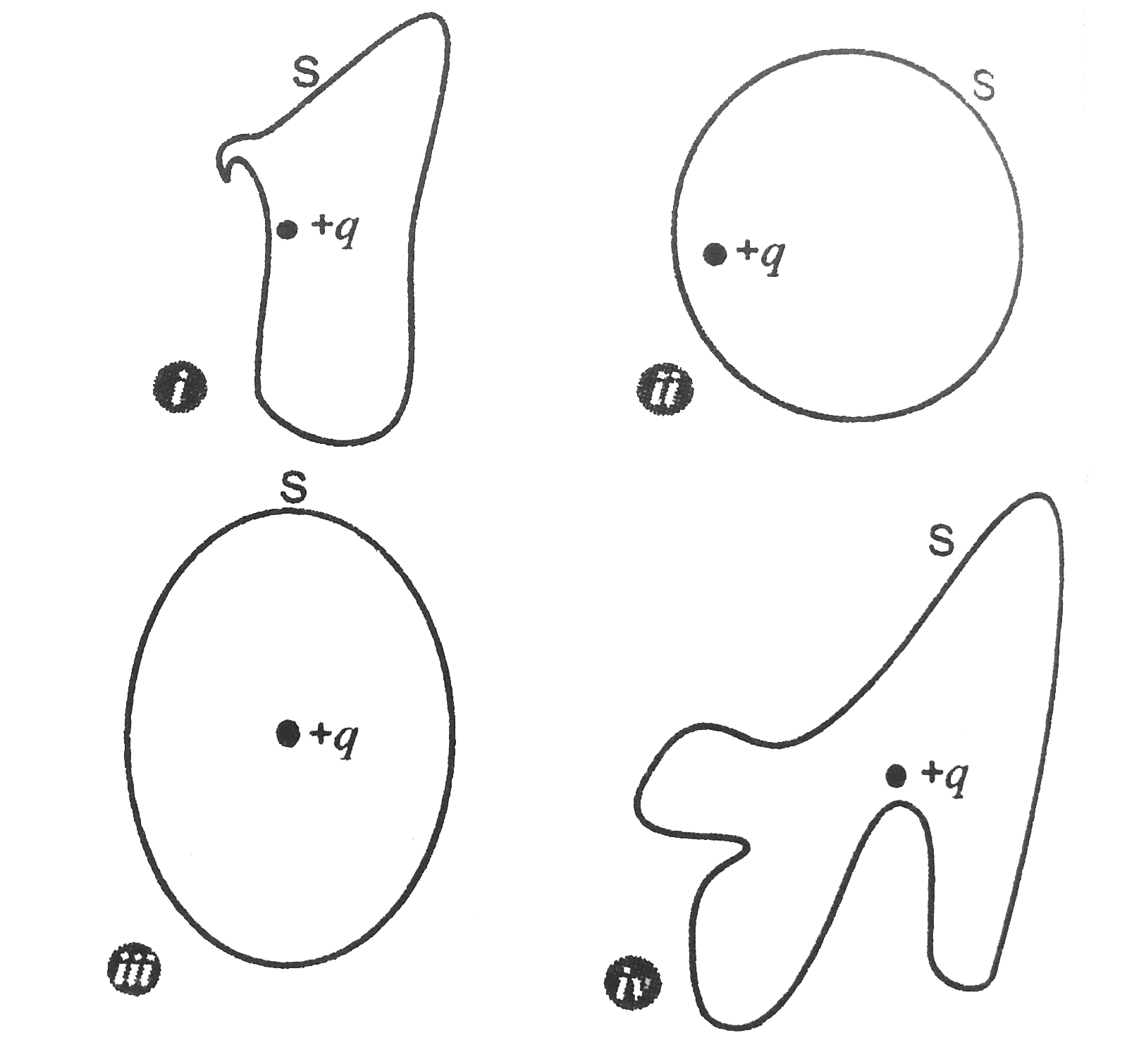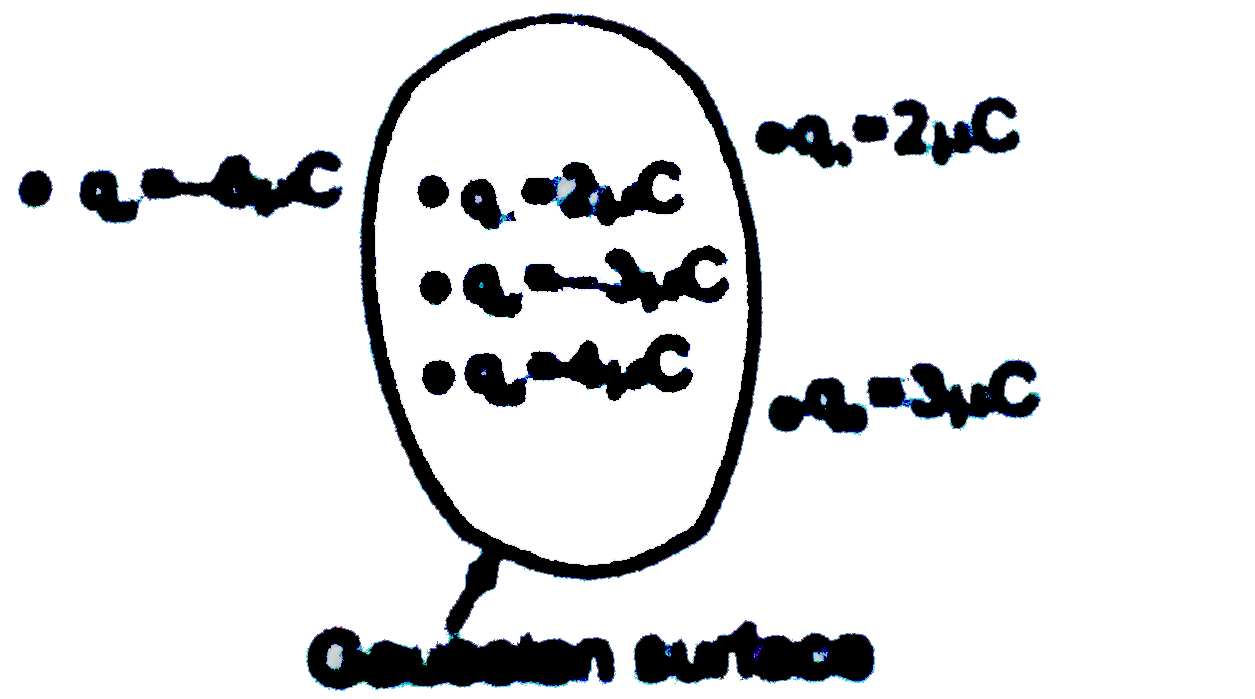Which of the following is true for electric-flux through a Gaussian surface ?
It depends on magnitude of charge enclosed by Gaussian surface
Electric flux is scalar quantity
Electric flux is independent of shape of Gaussian surface enclosing the charge
All are true
The correct Answer is:4
To determine which statements are true regarding electric flux through a Gaussian surface, we can analyze each option based on Gauss's law.
1. Understanding Gauss's Law:
Gauss's law states that the electric flux (Φ) through a closed surface (Gaussian surface) is directly proportional to the charge (Q) enclosed within that surface. Mathematically, it is expressed as:
Φ=Qε0
where ε0 is the permittivity of free space.
2. Analyzing Option 1:
- Statement: It depends on the magnitude of charge enclosed by the Gaussian surface.
- Evaluation: This statement is true because the electric flux is directly proportional to the charge enclosed. Thus, if the charge changes, the electric flux will also change.
3. Analyzing Option 2:
- Statement: Electric flux is a scalar quantity.
- Evaluation: This statement is also true. The electric flux is calculated using the charge (a scalar) divided by ε0 (a constant), which means the result is a scalar quantity.
4. Analyzing Option 3:
- Statement: Electric flux is independent of the shape of the Gaussian surface enclosing the charge.
- Evaluation: This statement is true as well. According to Gauss's law, the electric flux depends only on the charge enclosed and not on the shape or size of the Gaussian surface.
5. Conclusion:
Since all three statements are true, the correct answer is:
- Option 4: All are true.
Final Answer:
The correct choice is Option 4: All are true.
Gauss's law states that the electric flux (Φ) through a closed surface (Gaussian surface) is directly proportional to the charge (Q) enclosed within that surface. Mathematically, it is expressed as:
Φ=Qε0
where ε0 is the permittivity of free space.
- Statement: It depends on the magnitude of charge enclosed by the Gaussian surface.
- Evaluation: This statement is true because the electric flux is directly proportional to the charge enclosed. Thus, if the charge changes, the electric flux will also change.
- Statement: Electric flux is a scalar quantity.
- Evaluation: This statement is also true. The electric flux is calculated using the charge (a scalar) divided by ε0 (a constant), which means the result is a scalar quantity.
- Statement: Electric flux is independent of the shape of the Gaussian surface enclosing the charge.
- Evaluation: This statement is true as well. According to Gauss's law, the electric flux depends only on the charge enclosed and not on the shape or size of the Gaussian surface.
Since all three statements are true, the correct answer is:
- Option 4: All are true.
The correct choice is Option 4: All are true.
Topper's Solved these Questions
- ELECTRIC CHARGES AND FIELDS Book:AAKASH INSTITUTE ENGLISHChapter:ELECTRIC CHARGES AND FIELDS Exercise:SECTION-C ( OBJECECTIVE TYPE QUESTIONS)
Explore 2 Videos
- ELECTRIC CHARGES AND FIELDS Book:AAKASH INSTITUTE ENGLISHChapter:ELECTRIC CHARGES AND FIELDS Exercise:SECTION-D(LINKED COMPREHENSION TYPE QUESTIONS) COMPHREHENSION-1
Explore 3 Videos
- ELECTRIC CHARGES AND FIELDS Book:AAKASH INSTITUTE ENGLISHChapter:ELECTRIC CHARGES AND FIELDS Exercise:ASSIGNMENT(SECTION-A) Objective Type Question
Explore 45 Videos
- DUAL NATURE OF RADIATION AND MATTER Book:AAKASH INSTITUTE ENGLISHChapter:DUAL NATURE OF RADIATION AND MATTER Exercise:ASSIGNMENT (SECTION-D)
Explore 10 Videos
- ELECTROMAGNETIC INDUCTIONBook:AAKASH INSTITUTE ENGLISHChapter:ELECTROMAGNETIC INDUCTIONExercise:ASSIGNMENT(SECTION -D) Assertion-Reason type Question)
Explore 15 Videos
Similar Questions
An infinite, uniformly charged sheet with surface charge density σ cuts through a spherical Gaussian surface of radius R at a distance X from its center, as shown in the figure. The electric flux Φ through the Gaussian surface is .

View SolutionThe electric flux through the surface

View SolutionThe electric flux through the surface

View SolutionThe electric flux through the surface

View SolutionFind out flux through the given Gaussian surface.

View SolutionAn arbitrary surface encloses a dipole. What is the electric flux through this surface ?
View SolutionA point charge of 2.0μC is at center of a cublic Gaussian surface 9.0 cm on edge. What is the net electric flux through the surface?
View SolutionIf the flux of the electric field through a closed surface is zero,
View Solution(A): A point charge is lying at the centre of a cube of each side. The electric flux emanating from each surface of the cube is 1th6 total flux.
(R ): According to Gauss theorem, total electric flux through a closed surface enclosing a charge is equal to 1/ε0 times the magnitude of the charge enclosed.
View SolutionA closed surface encloses a net charge of −3.60μC. What is the net electric flux through the surface?
(b) The electric flux through a closed surface is found to be 780N−m2/C. What quantity of charge is enclosed by the surface?
(c) The closed surface in part (b) is a cube with sides of length 2.50 cm. From the information given in part (b), is it possible to tell where within the cube the charge is located? Explain.
View Solution